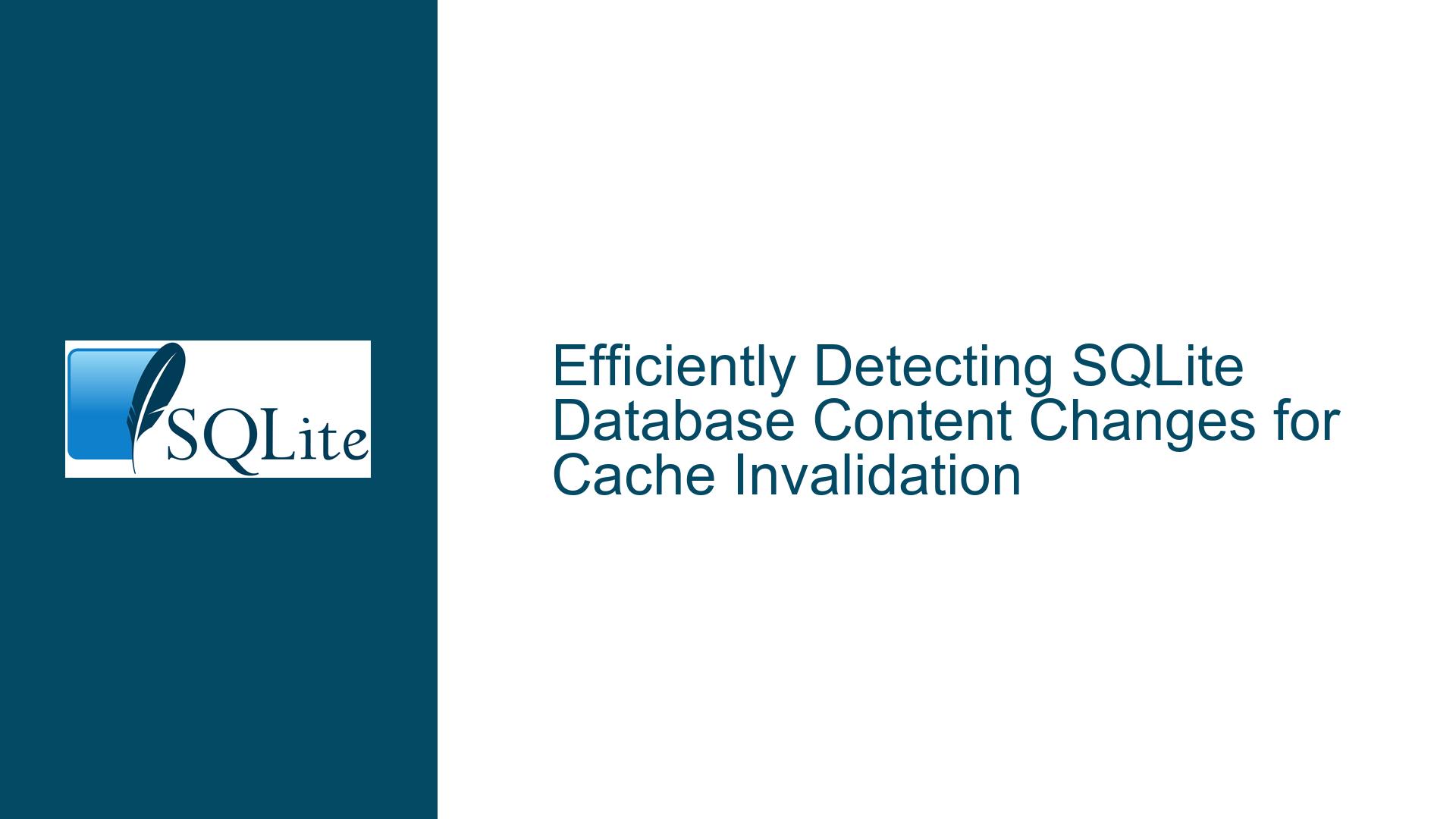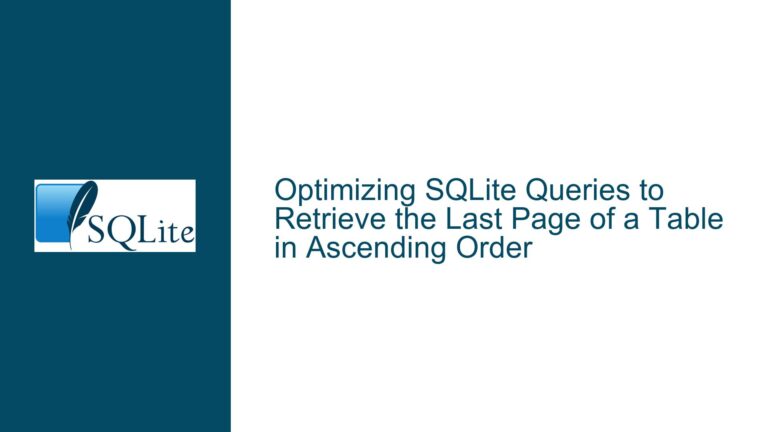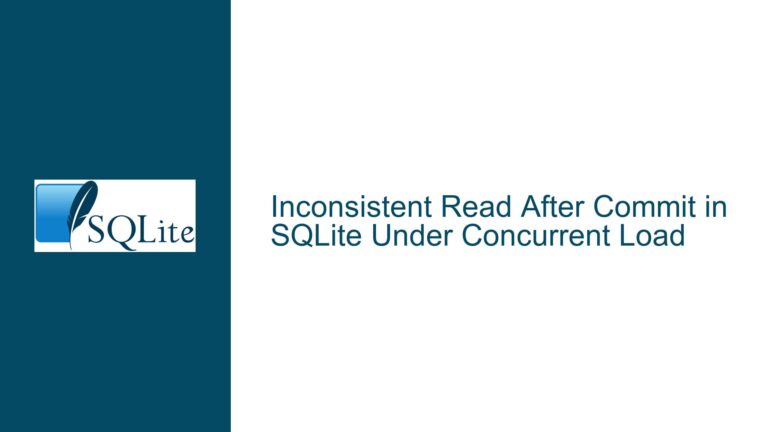Efficiently Detecting SQLite Database Content Changes for Cache Invalidation
Detecting Database Content Changes Using PRAGMA data_version
When working with SQLite databases, particularly in scenarios where caching is employed, it becomes crucial to determine whether the database content has changed. This is especially important for cache invalidation strategies, where the goal is to ensure that cached data remains consistent with the underlying database. One of the most efficient ways to detect changes in the database content is by leveraging the PRAGMA data_version command. This pragma returns a value that increments every time the database is modified by any connection. By periodically checking this value, you can determine whether the database content has changed without resorting to more computationally expensive methods like calculating file hashes or implementing complex trigger systems.
The PRAGMA data_version approach is particularly advantageous because it is lightweight and does not require any modifications to the database schema or the application logic. It works by maintaining a counter that is incremented whenever a write operation (insert, update, or delete) is performed on the database. This counter is stored in the database file header and is accessible through the PRAGMA data_version command. Since this pragma is designed to be fast and efficient, it is well-suited for scenarios where frequent polling is required, such as in cache invalidation mechanisms.
To implement this approach, you would typically open a secondary connection to the database that is dedicated solely to polling the PRAGMA data_version. This connection should be configured with a small cache size to minimize resource usage. By periodically executing the PRAGMA data_version command on this connection, you can detect changes in the database content and invalidate the cache accordingly. This method is both simple and effective, making it an ideal solution for detecting database content changes in a performant manner.
Potential Pitfalls of Using File Hashes and Triggers for Change Detection
While the PRAGMA data_version method is efficient, it is worth considering the alternatives and their potential drawbacks. One common approach is to calculate the MD5 hash of the database file on disk. This method involves reading the entire file and computing a hash value, which can then be compared to a previously stored hash to determine if the file has changed. While this method is straightforward, it is not without its limitations. Calculating the hash of a large database file can be computationally expensive, particularly if the operation needs to be performed frequently. Additionally, this method does not distinguish between changes to the database content and changes to the file metadata, such as modification timestamps, which can lead to false positives.
Another approach is to use triggers to track changes to the database content. This involves creating triggers on every table in the database that increment a counter in a dedicated content_version table whenever an insert, update, or delete operation is performed. While this method can provide precise information about changes to the database content, it comes with significant overhead. Implementing and maintaining triggers on every table can be complex and error-prone, particularly in large databases with many tables. Additionally, the triggers themselves can introduce performance overhead, particularly in write-heavy applications where the additional work of updating the content_version table can become a bottleneck.
In contrast, the PRAGMA data_version method avoids these pitfalls by providing a lightweight and efficient way to detect changes to the database content. It does not require any modifications to the database schema or the application logic, and it is designed to be fast and efficient, making it an ideal solution for cache invalidation and other scenarios where detecting database changes is critical.
Implementing PRAGMA data_version for Cache Invalidation
To implement the PRAGMA data_version method for cache invalidation, you will need to follow a few key steps. First, you will need to open a secondary connection to the database that is dedicated to polling the PRAGMA data_version. This connection should be configured with a small cache size to minimize resource usage. You can do this by executing the PRAGMA cache_size command on the secondary connection, setting it to a low value such as 100 or 200 pages. This ensures that the connection does not consume excessive memory while still being able to perform its polling function.
Next, you will need to periodically execute the PRAGMA data_version command on the secondary connection. This can be done using a simple loop that runs in a separate thread or process, depending on the architecture of your application. The loop should execute the PRAGMA data_version command at regular intervals, such as every few seconds or minutes, depending on the requirements of your application. Each time the command is executed, the returned value should be compared to the previously stored value. If the value has changed, it indicates that the database content has been modified, and the cache should be invalidated.
Here is an example of how this might be implemented in Python using the sqlite3 module:
import sqlite3
import time
# Open the primary connection to the database
primary_conn = sqlite3.connect('example.db')
primary_cursor = primary_conn.cursor()
# Open the secondary connection for polling PRAGMA data_version
secondary_conn = sqlite3.connect('example.db')
secondary_cursor = secondary_conn.cursor()
# Configure the secondary connection with a small cache size
secondary_cursor.execute('PRAGMA cache_size=100')
# Initialize the last known data_version
last_data_version = secondary_cursor.execute('PRAGMA data_version').fetchone()[0]
while True:
# Poll the data_version
current_data_version = secondary_cursor.execute('PRAGMA data_version').fetchone()[0]
# Check if the data_version has changed
if current_data_version != last_data_version:
print('Database content has changed. Invalidating cache...')
# Invalidate the cache here
last_data_version = current_data_version
# Wait for a short period before polling again
time.sleep(5)
In this example, the secondary connection is used to periodically poll the PRAGMA data_version. If the value changes, the cache is invalidated, and the new value is stored for future comparisons. This approach is simple, efficient, and does not require any modifications to the database schema or the application logic.
In conclusion, the PRAGMA data_version method is an efficient and effective way to detect changes in SQLite database content for cache invalidation purposes. It avoids the pitfalls of alternative methods such as file hashes and triggers, providing a lightweight and performant solution that is easy to implement and maintain. By following the steps outlined above, you can ensure that your cache remains consistent with the underlying database, even in scenarios where the database content changes infrequently.






